Basque Spain
I spent an enjoyable few years in Northern Spain, living in Vitoria-Gasteiz, capital of the Basque region; so here are some collected thoughts, recommendations and experiences....
Politics
Some (maybe boring to some) but important poliitics about this region. The autonomous community of the Basque Country should not be confused with the larger Basque Country (Basque: "Euskal Herria") of which it is a component part. The larger area is cause of contention.
The current laws configure the autonomous community as a federation of the three constituent provinces, which had been ruled locally since 1200 by their own laws and institutions in what is known as the Foral System. These autonomous regimes were curtailed in the 19th century, largely suspended under Franco, but restored by the Spanish Constitution of 1978. Under the new system the Diputaciones Forales (Basque: Foru Aldundiak) administer most of each of the provinces but are coordinated and centralized by the autonomous Basque Government (Spanish Gobierno Vasco, Basque: Eusko Jaurlaritza); however, the Foral still perform tax collection, coordinating with the Basque, Spanish and European governments.
The seats of the Basque Parliament and Government are in Vitoria-Gasteiz.

Spanish (Castillian) is the main language, but knowledge of Basque (Euskera) is common. English is not widely spoken. Euskera is the last remaining pre-Indo-European language in Western Europe.
Vitoria-Gasteiz
Vitoria (Spanish: Vitoria; Basque: Gasteiz; known officially as Vitoria-Gasteiz) is the capital of the Basque Country (Basque: Euskadi, Spanish: País Vasco).
Vitoria has at its heart an amazingly untouched medieval quarter, interesting museums and shopping along the fashionable Calle Dato. There are a number of boutiques and stores scattered through the centre, the largest of which is Gallerias Preciados - a large department store. There is a large out of town supermarket to the wet call Eroski.
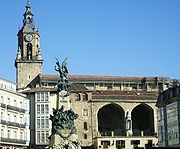
The photo shows the Church of St. Michael the Archangel in the Plaza de la Virgen Blanca; the image of the Virgen Blanca, patron saint of the city, lies in the porch. Like the rest of Spain, festivals play an important part of life, and the Fiestas de la Blanca is the most important in Vitoria. It is celebrated every year from the 4th to the 9th of August in honour of the Virgin, and features a programme of special events, activities and free open-air concerts, traditional music (eg using Txistularis - flutes (see http://www.nabasque.org/NABO/Music.htm for more details) is also played. Championship Pelota is also played at this time, and a procession of Giants (gigantes y cabezudos) is organised to entertain children.
Gigantes are hollow figures several meters tall and usually parade in couples of gigante and giganta ("giantess"). Cabezudos are big, hollow head masks covering the head and shoulders of the porter. An open mouth enables sight. The porter is usually in costume, and holds the mask with a hand. The other hand has a stick with a whip or pig bladder. With it he chases after children or young women. Sometimes he will pause to calm a weeping frightened child. Gigantes and Cabezudos represent local figures (past and present).
The festival begins at 6pm with the ringing of the bells of the Church of San Miguel and the traditional “chupinazo”, a rocket firework which is let off to mark the beginning of the festivals in honour of the Virgen Blanca. The “bajada del Celedón” – a life-size doll dressed in the traditional costume of this region and carrying a haversack, wineskin and umbrella, descends from the bell tower of the Church of San Miguel to the balcony of a house in the Plaza de la Virgen Blanca, apparently by means of an umbrella (Mary Poppins stylee). As Celedón descends over the Square, thousands of bottles of champagne are opened, cigars are lit and txistu and drums sound. Dressed in the traditional Alava shirt and red neck tie, on reaching the balcony, the puppet suddenly vanishes and is replaced by a real man, causing a tremendous roar from the square below.
At 1am on August 10, "Celedón" bids farewell to the city and ascends once more to the bell tower of San Miguel amidst fireworks and the "sobs" of everyone present.
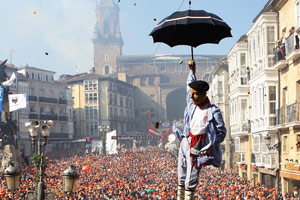
Food is very imprtant in the region, and one of my favourite restaurants is in a restored 15th Century mansion on the edge of the old town - El Portalon
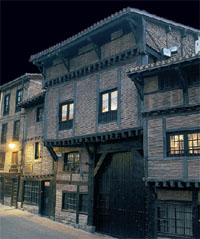
Also very good are:
- TEIDE - http://www.restauranteteide.com/
- DOS HERMANAS - Calle Madre Vedruna 10 http://www.restaurantedoshermanas.com/
- EL RINCON DE LUIS MARI, Rioja, 14 - For their Jabugo ham
Vitoria is located south of Bilbao, and I can recommend the drive south using the non-toll road (N-240) skirting the national park of Gorbeia which spans Álava and Bizkaia .
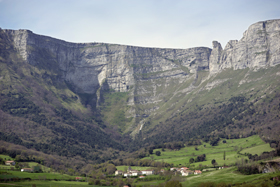
Nearby
Laguardia is the capital of the Rioja Alavesa region, to the south of Vitoria. The town was fortified in the 13th C, during the reign of Sancho VII, and the old town walls still stand. Laguardia still has its original medieval layout with a good number of fortified towers still surviving, two of which have been adapted to the new function of bell towers. Beneath the polished cobbled streets is a network of underground wine cellars; all of the houses have one. A few of the wine cellars can be visited.
Very near the town beside the Campillo winery is the award winning Villa Lucía Wine Centre, where visitors can tour the wine cellar museum. Of special interest too is the remarkable Ysios winery designed by Santiago Calatrava with it´s wave-like roof.
The “La Hoya Settlement” was first occupied 3.500 years ago during the mid Bronze age. Major defence works were built around this settlement, which took in an area of approximately 4 hectares, making it an important trading centre and crucial to the organisation of the territory. On-site there is a small museum that details the history of the place and displays some pieces recovered in the excavations. There are also numerous pre-historical burial monuments near La Hoya, such as the dolmens of San Martin, Älto de la Huesera, El Sotillo and la Chabola de la Hechicera (the hag’s shack).
The Balcón de la Rioja (Rioja balcony) located at the top of the Sierra is a wonderful vantage point from which to view the entire region. See here for route from Bilbao to the Rioja Balcony. http://www.dinastiavivanco.com is nearby, and virtually a place of pilgrimmage for wine drinkers.
Other interesting towns nearby include Labastida which as many important monuments. Also Elciego, with the new Marques de Riscal winery designed by Frank Gehry (of Guggenheim Museum Bilbao fame). The cities of Logroño and Haro are important wine producing towns and also worth visiting.
The "Salt Valley" of Salinas de Añana is an unusal sight - salt pans, built on terraces on the sides of a valley create a unique and spectacular landscape. The salt is still extracted by means of traditional methods based on the evaporation of water from the river Muera, which is channelled down the sides of the valley to the salt pans. See http://www.vallesalado.com/en/
Moving North, and along the coast, Castro Urdiales, is a modern town, although its Knights Templar castle and parish church, Iglesia de Santa Maria de la Asuncion, date from the Middle Ages. Its chief industries are tourism, fishing, and the preservation of fish, especially sardines and anchovies, in oil. The Lolin anchovy canning factory serves as a reminder of the town's closeness to this industry and its proximity to the sea. Don't miss the Mesón Marinero restaurant situated near the harbour - where local fishermen rub elbows with tourists. The tapas will tempt you, but you won't want to miss dinner in the second-floor dining room overlooking the fishing port. Another great restaurant here is El Segoviano - where they serve the Segovian specialty of roast suckling pig - served complete with snout and tail!
Santillana del Mar is a historic town situated slightly inland. This historical town features the Altamira Caves (Cuevas de Altamira - well preserved pre-historic cave paintings) and many historic buildings, and attracts thousands of holiday-makers every year. Unfortunately only visitors with special permission are allowed access to the caves, but the town is none the less worth a visit. There is an old saying that Santillana del Mar is The Town of Three Lies, since it is neither a Saint (Santo), nor flat (llana) and has no sea (Mar) as implied by the town's name. However, the name actually derives from Santa Juliana (or Santa Illana) whose remains are in the kept in the Colegiata, a Romanesque church and former Benedictine monastery.
Food
In addition to the usual restaurants you can also eat in bares (bars), asadores (restaurants specialising in roast food), sidrerías (specialist cider bars serving food), merenderos (picnic places), cervecerías (specialist beer bars serving food), bodegas (specialist wine bars serving food). See some of my favourite recipes listed here, more goodies:
- Stuffed Swiss chard
- Scrambled egg with perretxikos - St.George's mushrooms (also known as "sisas", "lansarones", spring mushrooms or "rayo de Orduña")
- Tarta Gasteiz
- Vasquitos y nesquitas - (assorted chocolates - ntaly produced by Goya)
- Lechal - Suckling baby lamb. Served as 1/4" slices, with the full rib attached; or roasted whole
- Cochonillo - suckling baby pig
- Callos - Tripe
- Congrio - Conger Eel
- Lengua de Ternera - Veal Tongue
- Caracoles - snails
- Txangurro is a starter crab dish where the claw meat is taken out of the cooked crab, flaked and stewed with vegetables, tomatoes, wine brandy and seasoning and served from the claw and after being baked in the oven
- Piquillo Peppers - The name piquillo means "little beak". Traditionally piquillo peppers are grown are hand picked then roasted over open fires. They are then peeled and de-seeded by hand, and packed into jars or tins for sale. Piquillo Peppers are often stuffed with meat, seafood or cheese, and served as tapa. Mainly sweet, sometimes spicy.
- Asparagus Blanca - white asparagus
- Turron - nougat
- Angulas - baby eels.
- Kokotxas - hake cheeks. Or any Hake disk (Merluza)
- Lubina con Txakoli - Sea bass in the local sharp white wine ( Txakoli)
- Piperada - sweet pepper omelet.
- Idiazabal - sheeps cheese
- A la vizcaína, or Biscayne style, describes a dish cooked in salsa vizcaína, a dried-pepper sauce. The dried peppers, called choriceros because of their importance in the production of chorizo sausages, are harvested at the end of the summer when ripe and hung from the facades of farmhouses to dry.
- Caparrones is a Spanish stew made of caparrón, a variety of red kidney bean, and a spicy sausage chorizo, both of which are local specialties of the Spanish La Rioja region. The shape of caparrón bean is shorter and rounder than common red kidney beans. The stew is regarded one of the most important dishes in Riojan cooking.
For snacking “pintxos / pinchos” or “tapas” offer a great way to taste different foods, and provide a good base for sampling the local wines and spirits. "Ir de pintxos" is the Basque version of a pub crawl. Pinchos are often accompanied by a txikito (small glass of wine) or a zurito (beer).
Aperitivo time (approximately 1pm – 3pm or in the evening between 8pm and 10pm is the time to sample pinchos. Serious eating in Spain does not start until at least 9pm. Normally pinchos are laid out on the bar and you help yourself to whatever you fancy. You put your cocktail sticks on a plate so that when you’ve finished and are ready to move on, the barman can count up how many pintxos you’ve had to work out your bill. Other food you can get in these places includes cazuelitas (small servings in earthenware bowls of different types of hot stew). The most popular cazuelitas are mushrooms in garlic, wild mushrooms with prawns, chorizo in cider, black pudding, snails etc
Patxaran
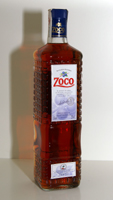 A sloe berry or baso aran (wild plum) liquor. A small dark berry with red juice, a sloe berry comes from a blackthorn bush and is a relative of the plum, while Patxaran is a sloe-flavoured liqueur most commonly drunk in Navarra, the Basque Country and La Rioja. Patxaran is made by soaking sloe berries in an anise-flavored spirit or arujo, with a few coffee beans and a vanilla pod for approximately 3 to 4 months, resulting in a light mahogany colored sweet liqueur, around 25-30% alcohol by volume. Traditionally, it is served chilled or on ice as a digestif
A sloe berry or baso aran (wild plum) liquor. A small dark berry with red juice, a sloe berry comes from a blackthorn bush and is a relative of the plum, while Patxaran is a sloe-flavoured liqueur most commonly drunk in Navarra, the Basque Country and La Rioja. Patxaran is made by soaking sloe berries in an anise-flavored spirit or arujo, with a few coffee beans and a vanilla pod for approximately 3 to 4 months, resulting in a light mahogany colored sweet liqueur, around 25-30% alcohol by volume. Traditionally, it is served chilled or on ice as a digestif
Ingredients for 1 litre:
3/4 of a kilo of sloe berries
Anise brandy or any white brandy
40 grams of sugar
3 coffee beans
1 vanilla bean
Wash the sloe berries and place them into a wide neck bottle. Fill the bottle with your hard liqueur of choice. If you desire a liqueur with a touch of sweetness, add sugar. Drop in the coffee and vanilla beans, cover the bottle and leave in a dark, cool place for at least three months. Other ingredients you can add include Chamomile or a cinnamon stick.Common Mixed Drinks
San fermãn: Patxaran with Cava
Butano or Butanito: Patxaran with orange juice
Pachalãn: Patxaran with lemon
Vaca-rosa (Pink Cow): Patxaran with milk
Sorbete-rosa: Patxaran with ice cream
Pacharã¡n del Bosque: Patxaran with red fruit juices
Pacharã¡nsete: Patxaran with soda water
RIOJA WinE
There are 3 rioja regions as shown, all rioja wines wil bear the red rioja label and an age classification

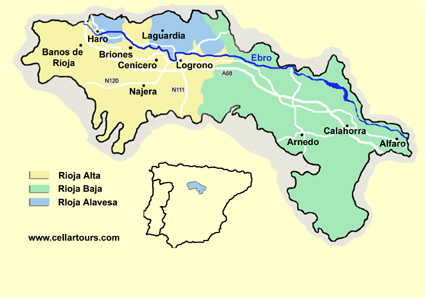
Map courtesy of http://www.cellartours.com/spain/spanish-wine-maps/
Rioja Aging Requirements
- Sin Crianza / Joven / Cosecha: Wine with little or no aging in oak casks. Must be comprised of 100% Rioja grapes, as with all Rioja guaranteed origin wines.
- Crianza: Wine in its 3rd year, matured for at least 1 year in oak cask, at least 1 year in bottle.
- Reserva: Carefully selected wines, aged for at least three years, of which at least one is in oak cask and the rest in the bottle.
- Gran Reserva: Wines which have been aged at least two years in oak cask and at least three years in the bottle.
See http://buber.net/Basque/, http://www.alavaturismo.com/, or http://www.turismoa.euskadi.net/ for loads of local info and history. For food & related supplies, see http://www.tienda.com/food/index.html
See also the Sunday Times article at http://www.telegraph.co.uk/travel/destinations/europe/spain/10055596/

